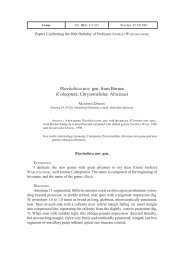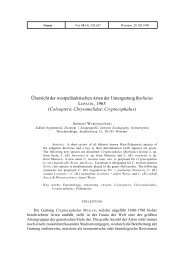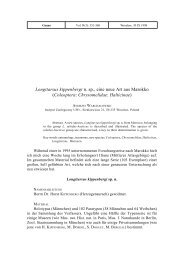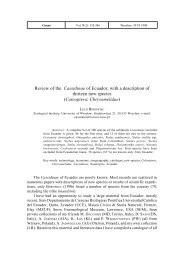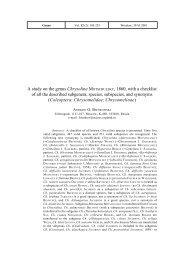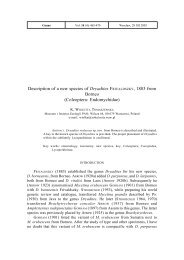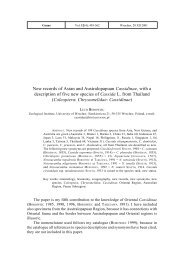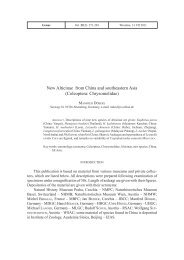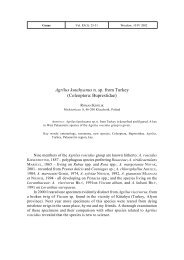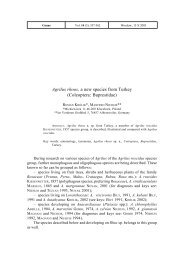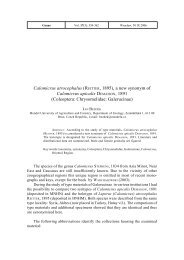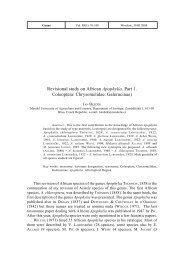Studies on asiatic Apophylia. Part 5: Revisional study of type ...
Studies on asiatic Apophylia. Part 5: Revisional study of type ...
Studies on asiatic Apophylia. Part 5: Revisional study of type ...
Create successful ePaper yourself
Turn your PDF publications into a flip-book with our unique Google optimized e-Paper software.
STUDIES ON ASIATIC APOPHYLIA<br />
505<br />
large deep depressi<strong>on</strong>s. Anterior margin slightly sinuate, posterior margin almost<br />
straight. Anterior and posterior margins thinly bordered, lateral margins indistinctly<br />
bordered. Anterior angles widely rounded, posterior angles obtusely<br />
angulate, rounded.<br />
Scutellum subtriangular, apex widely rounded, with small dense punctures<br />
and short pale hairs, dull.<br />
Elytra parallel, dull. Humeral calli well developed. Elytral surface very<br />
densely covered with small c<strong>on</strong>fused punctures and short pale hairs. Epipleura<br />
distinct, gradually narrowed to apex.<br />
Macropterous.<br />
Ventral surface lustrous, finely punctured and covered by pale hairs.<br />
Basimetatarsomere 1.6 times as l<strong>on</strong>g as two following metatarsomeres combined.<br />
Body length 4.20-7.10 mm (holo<strong>type</strong> 5.00 mm).<br />
The shape <strong>of</strong> aedeagus as in Fig. 31.<br />
Sexual dimorphism: Male: Last visible sternite with very deep subtriangular<br />
incisi<strong>on</strong>, claws bifid. Female: Last visible sternite complete, claws appendiculate.<br />
DISTRIBUTION<br />
India (Sikkim).<br />
DIAGNOSIS<br />
A. sikkimensis sp. nov. is very similar to A. velai BEZDÌK, 2003 (from Taiwan),<br />
A. clypeata SAMODERZHENKOV, 1988 (from Vietnam) and A. nigriceps LABOISSIÈRE,<br />
1927 (from China,Vietnam and Japan). All these species can be exactly identified<br />
<strong>on</strong>ly by the structure <strong>of</strong> aedeagus (Figs 25-27, 31).<br />
ETYMOLOGY<br />
Named after Sikkim, a Regi<strong>on</strong> <strong>of</strong> India where the <strong>type</strong> series was collected.<br />
<strong>Apophylia</strong> taiwanica n. sp.<br />
<strong>Apophylia</strong> asahinai: CHÛJÔ, 1963: 387 (Taiwan) (partim?); KIMOTO, 1965: 489 (Taiwan) (partim?);<br />
KIMOTO, 1966: 26 (Taiwan), 28 (key); KIMOTO, 1969: 22 (Taiwan); WILCOX, 1971: 142<br />
(partim?); KIMOTO, 1986: 56 (Taiwan) (partim?); KIMOTO, 1991: 9 (Taiwan) (partim?);<br />
KIMOTO & CHU, 1996: 54 (Taiwan) (partim?).<br />
<strong>Apophylia</strong> flavovirens: CHÛJÔ, 1935: 174 (see CHÛJÔ, 1962: 23) (partim?); CHÛJÔ, 1938: 135 (see<br />
CHÛJÔ, 1962: 23)(partim?).<br />
See also A. asahinai.<br />
TYPE MATERIAL<br />
Holo<strong>type</strong> (male) and 5 para<strong>type</strong>s (2 males, 3 females), labelled: “Taihorin<br />
Formosa H. Sauter, 1911 [w, p] // 7.VIII. [w, p] // Chujo det. [w, h]“ (in DEI); 11<br />
para<strong>type</strong>s (6 males, 5 female), labelled: “Taihorin Formosa H. Sauter, 1911 [w, p]<br />
// 7.VII. [w, p] // Chujo det. [w, h]“ (in DEI); 3 para<strong>type</strong>s (2 males, 1 female),



